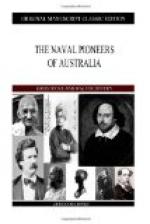We have a curious illustration of the state [Sidenote: 1748-1768] of the times in the manner of Cook’s treatment by the Viceroy of the Brazils, where, on the way out, he touched to refresh. The Viceroy pretended to believe that the ship was a merchantman, and not a king’s ship, and therefore wanted her to comply with certain port regulations which Cook was of opinion did not become the dignity of his commission. In evidence of the Endeavour being one of His Majesty’s ships, Cook wrote to the Viceroy and, among other things, drew attention to the distinctive uniform of his officers, which is a reminder to us that at this time the dress of naval officers was beginning to assume uniformity. George II. suggested the colours which were adopted by the Admiralty order in 1748, and, from admirals to lieutenants, officers were now dressed in blue coats with white facings, lace collars and cuffs, and gold trimmings. The uniform was continually changing, even up to within the last few years, and nowadays one naval officer has as many different suits of uniform as would have served all the commissioned officers of a line-of-battle ship in his father’s time.
When Cook left on this voyage he had, it has been shown, many advantages over Dampier in the matter of nautical instruments, but there is little doubt that he had absolutely no knowledge of the eastern coast of Australia. Dalrymple was the first to suggest that charts, which there is no doubt, did exist in Cook’s time, and which do indicate the eastern coast, were known to Cook. Without going into all the evidence rebutting Dalrymple’s insinuation, which has been discussed often enough, one fact is worth remembering: Dalrymple, the most learned geographer of the period, published his Historical Collection of Voyages in 1770, and in that work he makes no mention of the charts; but, on the contrary, his chart of the Pacific only indicates the coastline on the north and the west of the continent. Cook, who up to the moment of his appointment had been too busy at the practical work of his profession to find or study rare books or search libraries for documents and maps relating to the Pacific, was scarcely likely in 1768 to know what was not known to Dalrymple two years later; and also, be it remembered, Dalrymple was very indignant at being passed over in favour of Cook. It may be taken for granted that beyond such books as Dampier’s Voyage, De Brosses’ volumes, and such charts as the library of the Endeavour furnished, old maps afforded no help to Cook in his survey of New Holland. Of the charts Cook says something in his journal. In September, 1770, he writes:—




